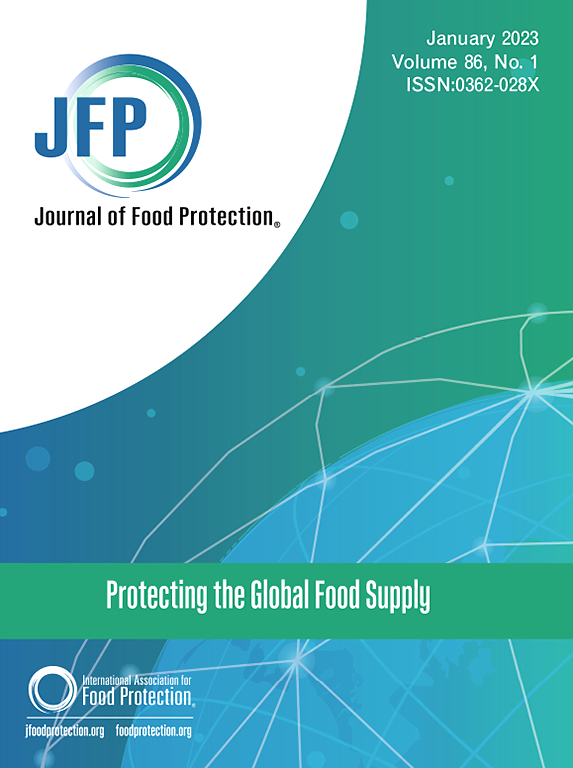2022-2023年两起与墨西哥进口新鲜和冷冻草莓有关的甲型肝炎病毒感染暴发调查
IF 2.1
4区 农林科学
Q3 BIOTECHNOLOGY & APPLIED MICROBIOLOGY
引用次数: 0
摘要
食源性甲型肝炎疾病和疫情与食用受甲型肝炎病毒携带者粪便污染的即食食品有关。疫情与从甲型肝炎流行、卫生和环境卫生条件不充分或缺乏或未执行食品安全标准的国家进口的新鲜和冷冻农产品有关。在2022年和2023年,联邦、州和国际合作伙伴调查了两起涉及同一HAV基因型IA菌株的多管辖区感染暴发,这些菌株与来自墨西哥下加利福尼亚州单一种植者的新鲜和冷冻有机草莓有关。这些导致美国和加拿大报告了39例病例,21例住院治疗,无死亡报告。美国食品药品监督管理局(FDA)、加拿大食品检验局(Canadian Food Inspection Agency)和美国各州合作伙伴于2022年对新鲜草莓进行了追溯调查,而FDA和美国各州合作伙伴于2023年对冷冻草莓进行了追溯调查。根据追溯调查,涉案草莓是在2022年生长季节收获的,并出售给新鲜和冷冻浆果市场。在2023年墨西哥的一次农场检查中,发现了农业实践中的漏洞,这些漏洞可能导致草莓受到甲型肝炎病毒的污染。FDA没有在与召回批次相关的两个冷冻草莓样品中检测到甲型肝炎病毒,也没有在2023年在受影响的种植者处收集的环境水样中检测到甲型肝炎病毒;在2022年的调查中没有收集样本。在环境水中检测到与人类粪便污染相关的指示生物(雄性特异性噬菌体和水蛭)。这些调查面临的挑战包括食品暴露的有限召回,与多个购买日期相关的暴露,在冷冻市场供应链中混合草莓,以及向公众传达这些暴发调查的复杂性。本文章由计算机程序翻译,如有差异,请以英文原文为准。
Investigation of Two Outbreaks of Hepatitis A Virus Infections Linked to Fresh and Frozen Strawberries Imported from Mexico – 2022–2023
Foodborne hepatitis A illnesses and outbreaks have been associated with the consumption of ready-to-eat foods contaminated with the feces of person(s) shedding hepatitis A virus (HAV). Outbreaks have been linked to fresh and frozen produce imported from countries where HAV is endemic, hygiene and sanitation are inadequate, or food safety standards are lacking or unenforced. In 2022 and 2023, federal, state, and international partners investigated two multijurisdictional outbreaks of infections involving the same HAV genotype IA strain linked to fresh and frozen organic strawberries sourced from a single grower in Baja California, Mexico. These resulted in 39 reported cases in the U.S. and Canada, 21 hospitalizations, and no reported deaths. The United States Food and Drug Administration (FDA), Canadian Food Inspection Agency, and U.S. state partners conducted traceback investigations for fresh strawberries in 2022, while FDA and U.S. state partners traced back frozen strawberries in 2023. Based on the traceback investigations, implicated strawberries were harvested during the 2022 growing season and sold to fresh and frozen berry markets. During a farm inspection in Mexico in 2023, gaps were observed in agricultural practices that could have contributed to the contamination of strawberries with HAV. FDA did not detect HAV in the two frozen strawberry samples linked to the recalled lots or environmental water samples collected at the implicated grower in 2023; no samples were collected during the 2022 investigation. Indicator organisms associated with human fecal contamination (male-specific coliphage and crAssphge) were detected in environmental water. Challenges in these investigations included limited recall of food exposures, exposures associated with multiple purchase dates, commingling of strawberries within the frozen market supply chains, and complexities with communicating these outbreak investigations to the public.
求助全文
通过发布文献求助,成功后即可免费获取论文全文。
去求助
来源期刊

Journal of food protection
工程技术-生物工程与应用微生物
CiteScore
4.20
自引率
5.00%
发文量
296
审稿时长
2.5 months
期刊介绍:
The Journal of Food Protection® (JFP) is an international, monthly scientific journal in the English language published by the International Association for Food Protection (IAFP). JFP publishes research and review articles on all aspects of food protection and safety. Major emphases of JFP are placed on studies dealing with:
Tracking, detecting (including traditional, molecular, and real-time), inactivating, and controlling food-related hazards, including microorganisms (including antibiotic resistance), microbial (mycotoxins, seafood toxins) and non-microbial toxins (heavy metals, pesticides, veterinary drug residues, migrants from food packaging, and processing contaminants), allergens and pests (insects, rodents) in human food, pet food and animal feed throughout the food chain;
Microbiological food quality and traditional/novel methods to assay microbiological food quality;
Prevention of food-related hazards and food spoilage through food preservatives and thermal/non-thermal processes, including process validation;
Food fermentations and food-related probiotics;
Safe food handling practices during pre-harvest, harvest, post-harvest, distribution and consumption, including food safety education for retailers, foodservice, and consumers;
Risk assessments for food-related hazards;
Economic impact of food-related hazards, foodborne illness, food loss, food spoilage, and adulterated foods;
Food fraud, food authentication, food defense, and foodborne disease outbreak investigations.
 求助内容:
求助内容: 应助结果提醒方式:
应助结果提醒方式:


